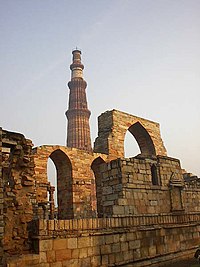
In the 12th and 13th centuries, Turkics and Pashtuns invaded parts of northern India and established the Delhi Sultanate at the beginning of the 13th century, in the former Rajput holdings. The subsequent Slave dynasty of Delhi managed to conquer large areas of northern India, approximate to the ancient extent of the Guptas, while the Khilji Empire was also able to conquer most of central India, but were ultimately unsuccessful in conquering and uniting most of the subcontinent. The Sultanate ushered in a period of Indian cultural renaissance. The resulting "Indo-Muslim" fusion of cultures left lasting syncretic monuments in architecture, music, literature, religion, and clothing. It is surmised that the language of Urdu (literally meaning "horde" or "camp" in various Turkic dialects) was born during the Delhi Sultanate period as a result of the inter-mingling of the local speakers of Sanskritic Prakrits with the Persian, Turkic and Arabic speaking immigrants under the Muslim rulers. The Delhi Sultanate is the only Indo-Islamic empire to stake a claim to enthroning one of the few female rulers in India, Razia Sultan (1236-1240).
A Turco-Mongol conqueror Timur began a trek starting in 1398 to invade the reigning Sultan Nasir-u Din Mehmud of the Tughlaq Dynasty in the north Indian city of Delhi.[ The Sultan's army was defeated on December 17, 1398. Timur entered Delhi and the city was sacked, destroyed and left in ruins; his army fell killing and plundering for three days and nights. He ordered except for the Sayyids, the scholars, and the other Mussulmans, the whole city to be sacked; 100,000 war prisoners, mostly Hindus, were put to death in one day.


No comments:
Post a Comment